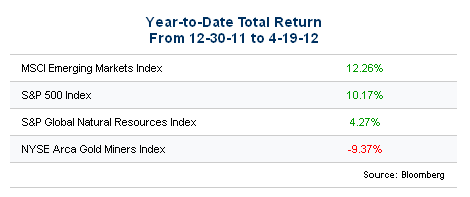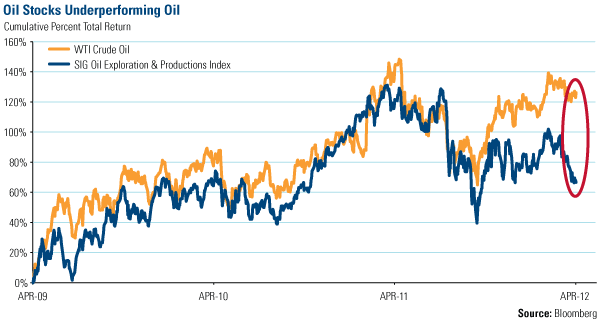Weighing the Evidence of Crude Oil and Gold Stocks
Commodities / Gold & Silver Stocks Apr 23, 2012 - 09:12 AM GMTBy: Frank_Holmes
 The MSCI Emerging Markets and the S&P 500 indices have increased double digits since the beginning of the year. Investors should be thrilled, but instead of cheers, the only sounds the markets are hearing are crickets. Many have been asking, where are the investors?
The MSCI Emerging Markets and the S&P 500 indices have increased double digits since the beginning of the year. Investors should be thrilled, but instead of cheers, the only sounds the markets are hearing are crickets. Many have been asking, where are the investors?
Since January 1, another $12 billion left U.S. stock mutual funds while about $100 billion went into bond funds. This continues a mutual fund outflow trend that has been ongoing for several months now.
After leading markets since the rebound began in 2009, natural resources and gold took a break while severely punished stocks saw a big bounce in the first quarter of 2012. Taking a look at the returns below, the S&P Global Natural Resources Index rose only 4 percent and the NYSE Arca Gold Miners Index (GDM) lost 9 percent.

As investment managers, we continuously weigh the evidence, dissecting macro factors in the market and comparing historical data. We believe this is the best way to find the next opportunity for our shareholders. Using history as our guide, we compared the performance of oil and gold companies against the results of the underlying commodities over the past three years.
West Texas Intermediate (WTI) crude oil has seen a tremendous rise over the past three years. In April 2009, the price of oil was $46 per barrel; today, it’s $104. The SIG Oil Exploration & Productions Index closely followed the rise of Texas tea from April 2009 until August 2011. That’s when the disparity between oil and oil stocks began to gradually increase.

Over the past three years, the price of oil and the index have had an average ratio of 0.21. Currently, it’s 0.26. That may not seem like a big difference but today’s ratio represents a three-year high and is a 3.13 standard deviation event. This means the divergence between oil and oil stocks is in “extreme territory” and, under normal assumptions, there is a 99 percent probability that the gap will close. Either the price of oil should come down or oil stocks go up, or a combination of both.
Gold and gold stocks are also experiencing extraordinary circumstances.
As we mentioned last week, gold equities continue to lag the price of gold, with the trend accelerating recently. Below, you can see that for most of the last three years, gold stocks have outperformed gold. Recently, though, bullion has surpassed gold stocks while gold companies have significantly declined.

The price of bullion and the NYSE Arca Gold Miners Index (GDM) have had a three-year average ratio of 0.94. Similar to oil and oil stocks, the ratio is now 1.28, a 3.06 standard deviation event.
CIBC commented earlier this week on the extreme disparity, saying the minor drop in bullion compared with the huge drop in gold stocks suggests that “a massive oversold position for the equities has occurred in the last month.” This is an “unprecedented” period for gold stocks, says CIBC.
Case Study: Newmont vs. Treasuries
Many American investors already have a stake in one of the world’s largest gold producers but they may not be aware of it. As a member of the S&P 500, you’ve probably acquired shares of Newmont Mining through a fund that tracks the broad index as it is the only gold company included in the index.
The company also boasts the highest dividend yield in the industry with an annualized dividend yield of nearly 3 percent. This is at least a percent higher than the 5- and 10-year Treasuries.
Through dividends, gold companies including Newmont make a commitment to return capital to shareholders. While gold stocks remain at depressed levels, dividends are especially attractive, as investors get “paid to wait” for shares to appreciate.
We believe in thinking contrarian and keeping a close eye on historical trends to discover inflection points, as stocks tend to eventually revert to their means. For example, in March 2009, we noted significant changes signaling the market had hit rock bottom; following that time through the end of the first quarter, the S&P 500 Index rose more than 100 percent.
Today’s extreme divergence in oil and gold stocks and their underlying commodities presents a rare opportunity: what these stocks need now are investors to take advantage of it.
U.S. Global Investors, Inc. is an investment management firm specializing in gold, natural resources, emerging markets and global infrastructure opportunities around the world. The company, headquartered in San Antonio, Texas, manages 13 no-load mutual funds in the U.S. Global Investors fund family, as well as funds for international clients.
For more updates on global investing from Frank and the rest of the U.S. Global Investors team, follow us on Twitter at www.twitter.com/USFunds or like us on Facebook at www.facebook.com/USFunds. You can also watch exclusive videos on what our research overseas has turned up on our YouTube channel at www.youtube.com/USFunds.
By Frank Holmes
CEO and Chief Investment Officer
U.S. Global Investors
U.S. Global Investors, Inc. is an investment management firm specializing in gold, natural resources, emerging markets and global infrastructure opportunities around the world. The company, headquartered in San Antonio, Texas, manages 13 no-load mutual funds in the U.S. Global Investors fund family, as well as funds for international clients.
All opinions expressed and data provided are subject to change without notice. Some of these opinions may not be appropriate to every investor.
Standard deviation is a measure of the dispersion of a set of data from its mean. The more spread apart the data, the higher the deviation. Standard deviation is also known as historical volatility. All opinions expressed and data provided are subject to change without notice. Some of these opinions may not be appropriate to every investor. The S&P 500 Stock Index is a widely recognized capitalization-weighted index of 500 common stock prices in U.S. companies. The NYSE Arca Gold BUGS (Basket of Unhedged Gold Stocks) Index (HUI) is a modified equal dollar weighted index of companies involved in gold mining. The HUI Index was designed to provide significant exposure to near term movements in gold prices by including companies that do not hedge their gold production beyond 1.5 years. The MSCI Emerging Markets Index is a free float-adjusted market capitalization index that is designed to measure equity market performance in the global emerging markets. The U.S. Trade Weighted Dollar Index provides a general indication of the international value of the U.S. dollar.
Frank Holmes Archive |
© 2005-2022 http://www.MarketOracle.co.uk - The Market Oracle is a FREE Daily Financial Markets Analysis & Forecasting online publication.



